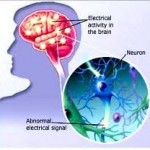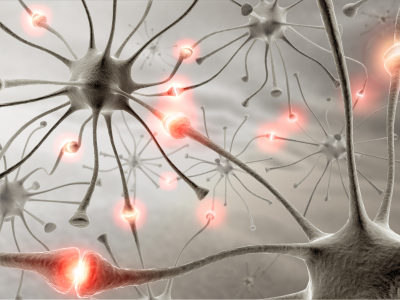Not every type of epilepsy is generalized. A person could have seizure activity without impairment of his consciousness. There is an entity called “simple partial seizures” that results from epileptic activity in a small portion of the brain.
 People experiencing a simple partial seizure can behave normally during seizures. Simple partial seizures have many types but I will only discuss the one in which people have repeated and unexplained episodes of abdominal symptoms. This type of partial seizures is also called autonomic seizures or abdominal seizures because it involves the autonomic nervous system (ANS) of the brain. ANS controls many dynamic functions of the human body such as heart rate, gut motility, sexual functions, maintaining blood pressure while in motion, urination, sweating, tear flow, fear reaction and more.
People experiencing a simple partial seizure can behave normally during seizures. Simple partial seizures have many types but I will only discuss the one in which people have repeated and unexplained episodes of abdominal symptoms. This type of partial seizures is also called autonomic seizures or abdominal seizures because it involves the autonomic nervous system (ANS) of the brain. ANS controls many dynamic functions of the human body such as heart rate, gut motility, sexual functions, maintaining blood pressure while in motion, urination, sweating, tear flow, fear reaction and more.
Abdominal epilepsy, sometimes referred to as autonomic seizures, is a very rare form of seizure which presents with the acute onset of symptoms seemingly related to the gastrointestinal system. It is more likely to occur in children. Sudden abdominal pain and other symptoms can occur which are generally first thought to be related to abdominal disease such as irritable bowel syndrome or gastroenteritis. However, in a small set of patients it has been shown that these symptoms can occur along with seizure activity in the brain, demonstrated by electroencephalogram, and may respond to treatment with antiepileptic medications.
What Causes Abdominal Epilepsy?
No one knows what causes abdominal epilepsy. Because the condition is so rare, no high-quality studies exist. There have been too few reported cases to identify risk factors, genetic factors, or other potential causes.
What Types of Symptoms Are Typical?
 Little is known about abdominal epilepsy. There have only been 36 cases reported in medical journals in the last forty years.
Little is known about abdominal epilepsy. There have only been 36 cases reported in medical journals in the last forty years.
With abdominal epilepsy, it’s thought that seizures occur that primarily affect the digestive system. Gastrointestinal symptoms are the result.
Patients generally complain of recurrent paroxysms, or attacks, of abdominal symptoms such as pain, nausea, gas and bloating and even abdominal twitching. In some cases these attacks can be followed by more typical seizure activity such as a generalized seizure. Likewise, these attacks can occur in patients who at other times experience other types of seizures. While some patients only experience abdominal or gastrointestinal type symptoms with the attacks, some may also have alterations in their level of consciousness.
People with reported abdominal epilepsy have different patterns of symptoms. Further, symptoms may vary in the same person from one time to the next. For example, a person might have convulsive seizures and abdominal pain during one episode. Then the person may only have abdominal pain during another seizure.
How Is The Diagnosis Typically Made?
 Because abdominal epilepsy is such a rare condition and can be mistaken for many much more common ailments, it can be difficult to make the diagnosis. Diagnosing abdominal epilepsy can involve a chicken-or-the-egg debate. Seizures in epilepsy are sometimes preceded by patterns of symptoms. These patterns of symptoms are called auras. Just before a seizure, some people with epilepsy might smell something that’s not there. Others might see flashing lights.
Because abdominal epilepsy is such a rare condition and can be mistaken for many much more common ailments, it can be difficult to make the diagnosis. Diagnosing abdominal epilepsy can involve a chicken-or-the-egg debate. Seizures in epilepsy are sometimes preceded by patterns of symptoms. These patterns of symptoms are called auras. Just before a seizure, some people with epilepsy might smell something that’s not there. Others might see flashing lights.
Auras with abdominal symptoms are common in epilepsy. You can call it a gut feeling. Nausea, pain, flatulence, or hunger can herald a seizure. But are the abdominal symptoms ever evidence of seizures in their own right?
Some experts think the diagnosis of abdominal epilepsy should be made when abdominal symptoms are the main manifestation of seizure activity.
Definitive diagnosis is generally considered to require an electrocephalogram which demonstrates seizure activity in the brain during one of the abdominal episodes. Response to anti-seizure medications also supports the diagnosis since other causes of gastrointestinal upset do not typically respond to these medications.
The other proposed criterias for the diagnosis of abdominal epilepsy are:
- periodic abdominal symptoms that can’t be explained after extensive medical testing, including blood tests, imaging scans, and endoscopy
- symptoms that suggest a central nervous system problem (for example, confusion or lethargy)
- sustained absence of abdominal symptoms while taking an epilepsy medication
Medical and neurologic testing might include:
- computed tomography (CT) scans of the abdomen and brain
- magnetic resonance imaging (MRI) scan of the brain
- ultrasound of the abdomen
- endoscopy of the gastrointestinal tract, either upper (through the mouth), lower (through the rectum), or both
- blood tests
What Are Some Common Treatments?
As stated above, because the symptoms are related to seizure activity in the brain, prevention of the seizures with antiepilepsy medications may help to control the abdominal symptoms. Dilantin (phenytoin) is often used. Since no controlled studies exist, though, other drugs might be equally effective. Other epilepsy treatments may be considered as for other forms of epilepsy in cases which are difficult to control. Each patient is different and should discuss their treatment options with their own treating physicians.
In the known cases of abdominal epilepsy, treatment with epilepsy drugs has usually significantly reduced abdominal symptoms. That’s not proof that the abdominal symptoms were caused by seizures, though. Epilepsy drugs act on nerves in general. They might simply soothe abdominal pain that way, or through a placebo effect.
